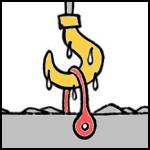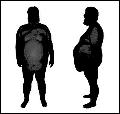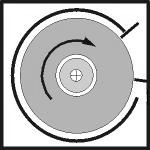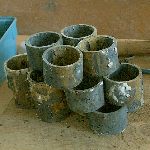|
| |||||||||
| |||||||
| |||||||
| |||||||
|
| ||||||
|
| ||||||
| |||||||
| |||||||
| |||||||
| |||||||
| |||||||
| |||||||
| |||||||
| |||||||
| |||||||
| |||||||
| |||||||
| |||||||
| |||||||
| |||||||
|
| |||||||
|
Health and Safety information for Metalworkers.
Dieting Heart Diabetes
|

anvilfire.com
Health and Safety Page
| ||
|---|---|---|
|
It takes time and practice to learn hammer control and develop the necessary strength. Start with a relatively light hammer of 1-1/2 to 2-1/2 pounds (700 to 1000 g). Work up in 1/4 pound (100 g) increments to a heavier weight. Listen to your body. Little pains can be warnings of future problems. - anvilfire.com
| ||

| ||

|
NEW!
The Guru's Story : Part I Self Intervention
Saving one's life through superior nutrition. How and why I became a Nutritarian. Follow the progress. Personal Recipes, links and more. Part II - Lowering Sodium Part III - Exercise Part IV - Eating Out | |

|
The Vegetarian, the Vegan and the Nutritarian
Moral life styles meet scientific nutrition. Healthy Vegetarian recipes, links and more. Easy Vegetarian Meals Sheri's Balanced Beans Sheri's fresh Home Made Salsa | |

| ||

|
Health and Fitness Videos
Select YouTube health, diet and fitness videos. NEW! Continuous Chest Compression CPR | |

|
SAFETY GLASSES and and Wire Wheel Safety
A graphic example of why safety glasses are SO important. | |

|
Grinding Wheel Safety
Wheels and guards, testing and adjusting. | |

|
Metal Fume Fever
Burning and welding galvanized and zinc plated metal. How the loss of one man's life may save yours. | |

|
"Getting Away With It"
Famous last words. "Hey VERN Watch This!" |
- Disturbing Information for Welders
New Scientist magazine recently published a short note [in the Feb. 1' 2001 issue] reviewing an article in Neurology, vol. 56, p 8.UNWELL WELDERS
Please note that the number of cases seen, is small, and is not statistically, valid. More cases will have to be investigated at their clinic and others. But it raises a strong suspicion.
Fumes generated during welding may accelerate the onset of Parkinson's disease. Brad Racette of Washington University in St. Louis and his team compared 15 cases of Parkinson's disease in welders with 15 other cases at their clinic. The only difference between the groups was the average age Parkinson's set in, which was 15 years earlier for welders [Neurology, vol 56, p 8]. the culprit may be manganese."We know it can cause damage in the right area of the brain," says Racette.
Manganese fumes should be avoided, by the use of very good ventilation, preferably, to the outside and use of a respirator with activated charcoal cartridges. NOTE that the suspected metal is manganese and NOT magnesium. But I would suggest that none of us inhale magnesium fumes either, just to be cautious. Parkinson's disease is a nasty way to decline and die. - Slag.
Almost all steel contains some manganese but there are manganese alloys and tool steels that have much more than common mild or structural steel. Certain types of welding rods for welding high performance alloys and hard facing contain much higher amounts of manganese. All welding fumes should be avoided but it appears that specialty rods may be even more hazardous. - guru
- Activated charcoal cartridge respirators should be stored in air tight containers in order that they stop
absorbing gases from the air when we are not using them. The cartridges will last longer that way. - Slag
- First Aid Kits should be sited near floor level. That way a smith that is bleeding heavily can get to a bandage or pressure
wrap in order to stop the bleeding. That person may not have enough blood pressure to stand up to get to a first aid kit located at chest level .
Needless to say I relocated my kit p.d.q. - Slag
The point of a first aid kit being low it a good idea if it can be accessed. Most blacksmith shops are so full of heavy stuff that if all you can do is crawl then it may not matter where you put it. In any shop in the U.S. covered by OSHA (those having an employee) there are rules as to mounting a first aid kit in a conspicuous place which I BELIEVE includes mounting height. However, there is no reason not to have a second kit anywhere you want it. - guru
- Filter Masks such as hospital surgical masks, do not protect the wearer from environmental dust or fumes.
They stop a small percentage of particulates but the rest go around the mask.
These masks are designed to keep the wearer from sneezing or spiting outward.
Filter masks with a rubber frame that fits the face help reduce the intake of environmental dust.
However, fumes and gases are not stopped by particulate (paper) filters.
If you need protection from fumes and gases this requires a special filter such as an activated charcoal filter that is rated for the particular fumes.
If you use one general purpose mask in your shop then it needs to be a combination particulate and charcoal filter.
None of the above work unless they fit your face. Beards and filter masks do not work together.
The best lung protecting is good forced ventilation in your shop. Welders should use localized exhaust fans.
HAZARDS GENERAL
- The OSHA rules above are primarily for manufacturers but also apply to any shop with employees and are simple enough to retrofit to our personal machines.
Treadle Guards prevent the accidental operation of the hammer and are about the only OSHA requirement on small hammers. However, mechanical hammers with coil springs in the toggle such as Little Giants should be fitted with a flying parts guard. It is common for these these springs to shatter and they are right at head height. Shattering springs break like all highly stressed hard steels with long twisting fractures with sharp ends. Put guards on those hammers!
- Keep Work Flat on Dies. Pay close attention to how you place work on hammer dies.
On large hammers one of the common injuries to workers is shoulder dislocation when the hammer strikes work that is not held flat on the dies and pulls it downwards.
However, upwards can be a problem too. In extreme cases the worker has been launched across the shop.
Even working small hammers the work jerking out of you hands or jarring joints can be a problem.
- Use Short Tools
All professional power hammer tools are as short as possible.
Lately it has become "fashionable" to use standard tools under power hammers, especially the air hammers with long strokes.
This is extremely BAD PRACTICE and is very dangerous. A miss strike and the tool as well as the HOT work will fly out of the hammer.
Take time to make proper tooling for your hammer. DO NOT use standard handled or unhandled punches or chisels under a power hammer. - guru

Equipment and heavy load moving how-to and safety.
Chain Hoists How they work, inspection, use.